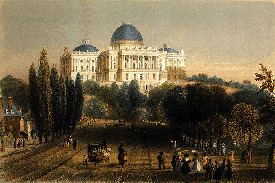The Nineteenth United States Congress was a meeting of the legislative branch of the United States federal government, consisting of the United States Senate and the United States House of Representatives. It met in Washington, D.C. from March 4, 1825, to March 4, 1827, during the first two years of the administration of U.S. President John Quincy Adams. The apportionment of seats in the House of Representatives was based on the Fourth Census of the United States in 1820. The Senate had a majority of Jackson Men, while the House had an Anti-Jackson (pro-Adams) majority.
March 4, 1825: John Quincy Adams inaugurated as President of the United StatesOctober 26, 1825: The Erie Canal opened, providing passage from Albany, New York, to Buffalo and Lake Erie.July 4, 1826: Both Thomas Jefferson and John Adams died on the 50th Anniversary of America's Independence[Data unknown/missing. You can help!]November 7, 1825: Treaty of St. Louis: 1,400 Missouri Shawnees were forcibly relocated from Missouri to KansasJanuary 24, 1826: Treaty of Washington between the United States government and the Creek National Council, in which they ceded much of their land in GeorgiaThe count below identifies party affiliations at the beginning of the first session of this congress. Changes resulting from subsequent replacements are shown below in the "Changes in membership" section.
President: John C. Calhoun (J)President pro tempore: John Gaillard (J), until December 4, 1825Nathaniel Macon (J), from May 20, 1826Speaker: John W. Taylor (A)This list is arranged by chamber, then by state. Senators are listed in order of seniority, and Representatives are listed by district.
Skip to House of Representatives, belowSenators were elected by the state legislatures every two years, with one-third beginning new six-year terms with each Congress. Preceding the names in the list below are Senate class numbers, which indicate the cycle of their election. In this Congress, Class 1 meant their term ended with this Congress, requiring reelection in 1826; Class 2 meant their term began in the last Congress, requiring reelection in 1828; and Class 3 meant their term began in this Congress, requiring reelection in 1830.
This count reflects changes from the beginning of the first session of this Congress.
replacements: 7Adams (A): 3-seat net gainJacksonian (J): no net changedeaths: 4resignations: 6interim appointments: 4Total seats with changes: 13replacements: 11Anti-Jackson: 1 seat net gainJackson Men: 1 seat net lossdeaths: 5resignations: 10contested election: 1Total seats with changes: 16Lists of committees and their party leaders.
AgricultureAudit and Control the Contingent Expenses of the SenateBankruptcy (Select)ClaimsCommerceDebt Imprisonment Abolition (Select)Distributing Public Revenue Among the States (Select)District of ColumbiaFinanceForeign RelationsFrench Spoilations (Select)Georgia and the Creek Indians (Select)Indian AffairsJudiciaryManufacturesMilitary AffairsMilitiaNaval AffairsPensionsPost Office and Post RoadsPrivate Land ClaimsPublic LandsRoads and Canals (Select)Tariff Regulation (Select)WholeAccountsAgricultureAmerican Colonization Society (Select)Apportionment of Representatives (Select)Bills of Exchange (Select)ClaimsCommerceDistrict of ColumbiaElectionsExpenditures in the Navy DepartmentExpenditures in the Post Office DepartmentExpenditures in the State DepartmentExpenditures in the Treasury DepartmentExpenditures in the War DepartmentExpenditures on Public BuildingsForeign AffairsIndian AffairsManufacturesMilitary AffairsMilitary PensionsNaval AffairsPost Office and Post RoadsPublic ExpendituresPublic LandsRevisal and Unfinished BusinessRevolutionary ClaimsRules (Select)Standards of Official ConductTerritoriesWays and MeansWholeEnrolled BillsPolice and Preservation of the CapitalArchitect of the Capitol: Charles BulfinchLibrarian of Congress: George WatterstonChaplain: William Staughton (Baptist), elected December 12, 1825William Ryland (Methodist), elected December 8, 1826Secretary of the Senate: Charles Cutts, until December 12, 1825Walter Lowrie, elected December 12, 1825Sergeant at Arms: Mountjoy BaylyChaplain: Reuben Post (Presbyterian)Clerk: Matthew St. Clair ClarkeDoorkeeper: Benjamin BirchSergeant at Arms: John O. Dunn 
